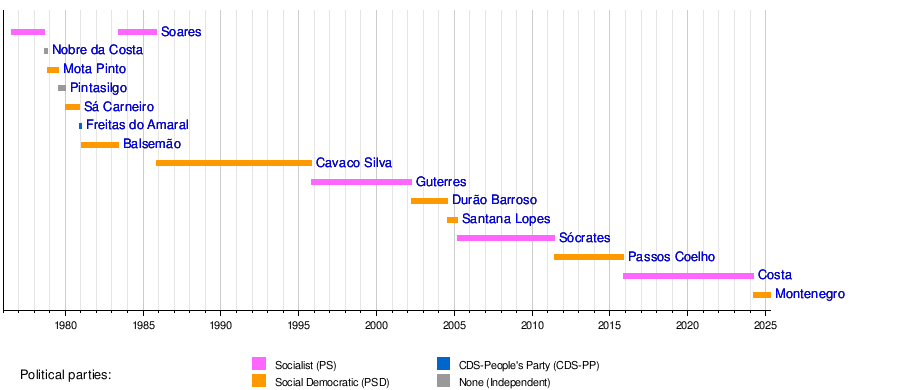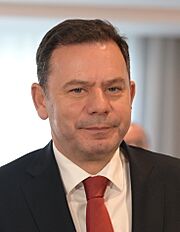Prime Minister of Portugal facts for kids
Quick facts for kids Prime Minister of thePortuguese Republic |
|
|---|---|

Flag of the prime minister
|
|

Government logo
|
|
| Council of Ministers of Portugal Government of Portugal |
|
| Style | Mr Prime Minister (informal) His Excellency (diplomatic) |
| Member of |
|
| Residence | Palacete de São Bento |
| Seat | Lisbon, Portugal |
| Appointer | President |
| Term length | No term limit |
| Inaugural holder | Pedro de Sousa Holstein, 1st Duke of Palmela |
| Formation | 24 September 1834 |
| Salary | €116,144 annually |
The prime minister of Portugal (Portuguese: primeiro-ministro; pronounced [pɾiˈmɐjɾu miˈniʃtɾu]) is the head of government of Portugal. As head of government, the prime minister coordinates the actions of ministers, represents the Government of Portugal to the other bodies of state, is accountable to parliament and keeps the president informed. The prime minister can hold the role of head of government with the portfolio of one or more ministries. As Portugal is a semi-presidential parliamentary republic, the prime minister is the country's leading political figure and de facto chief executive.
There is no limit to the number of terms a person can serve as prime minister. The prime minister is appointed by the president following legislative elections, after having heard the parties represented in the parliament. Usually, the person named is the leader of the largest party in the previous election, but there have been exceptions over the years.
Contents
History
Since the Middle Ages, some officers of the Portuguese Crown gained precedence over the others, serving as a kind of prime ministers. Over time, the role of principal officer of the Crown fell upon the chanceler-mor (chancellor), the mordomo-mor (mayor of the palace) and the escrivão da puridade (king's private secretary).
The first modern prime minister of Portugal was Pedro de Sousa Holstein, 1st Duke of Palmela, who was sworn in on 24 September 1834, as Presidente do Conselho de Ministros (President of the Council of Ministers). In 1911, the official title of the prime minister became Presidente do Ministério (President of the Ministry). In 1933, it became again Presidente do Conselho de Ministros.
The present title Primeiro-Ministro (Prime Minister), attributed to the head of the Government of Portugal, was officially established by the Constitution of 1976 after the revolution of 25 April 1974
Officeholders
The incumbent prime minister of Portugal is Luís Montenegro, who took office on 2 April 2024 as the 14th prime minister of the Third Portuguese Republic. The official residence of the prime minister is the Palacete de São Bento, a mansion next to São Bento Palace, which, in confusion, is sometimes also called "São Bento Palace".
Portuguese prime ministers of the Third Portuguese Republic:
- 1st Mário Soares (two terms);
- 2nd Alfredo Nobre da Costa;
- 3rd Carlos Mota Pinto;
- 4th Maria de Lourdes Pintasilgo;
- 5th Francisco Sá Carneiro;
- (interim) Diogo Freitas do Amaral – Deputy Prime Minister;
- 6th Francisco Pinto Balsemão (two terms);
- 1st Mário Soares (third term);
- 7th Aníbal Cavaco Silva (three terms);
- 8th António Guterres (two terms);
- 9th José Manuel Barroso;
- 10th Pedro Santana Lopes;
- 11th José Sócrates (two terms);
- 12th Passos Coelho (two terms);
- 13th António Costa (three terms);
- 14th Luís Montenegro;
Prime minister's residence
Just behind the main building of the Assembly of the Republic, there is a mansion that serves as residence and office for the prime minister of Portugal. The mansion, dated from 1877, was built within the garden of the old monastery that held the Portuguese parliament. It has been the prime minister's official residence since 1938, when Salazar moved in. Although it is the official residence of the prime minister, not all incumbents have lived in the mansion during their term in office.
List of prime ministers of Portugal
Term of office in years
Graphical timeline (since 1976)

Historical rankings of prime ministers
In 2012 and 2014 newspaper i and the polling agency Pitagórica conducted polls asking for the best Portuguese prime minister among the seven most recent ones (i.e. in the previous 30 years). The results revealed that the public clearly separated the seven evaluated prime ministers between the three best ones (each receiving more than 20% of the votes) and the four worst (each receiving from 4 to 8% of the votes). In both polls, António Guterres (1995–2002) ranked as the best prime minister. Mário Soares (1976–78 and 1983–85) and Aníbal Cavaco Silva (1985–95) were also among the best prime ministers. On the other hand, José Manuel Durão Barroso (2002–04), Pedro Santana Lopes (2004–05), José Sócrates (2005–11) and Pedro Passos Coelho (2011–15, incumbent at the time of the polls) ranked as the worst prime ministers. Pedro Santana Lopes was ranked the worst in the 2012 poll while Barroso ranked as the worst in the 2014 one. Together, the three best prime ministers ruled Portugal uninterruptedly from 1983 to 2002, while the four worst ruled from 2002 to 2015.
| Prime Minister | Party | Tenure | 2012 | 2014 |
|---|---|---|---|---|
| António Guterres | PS | 1995–2002 | 26.8% | 24.2% |
| Mário Soares | PS | 1976–1978 1983–1985 |
22.7% | 23.9% |
| Aníbal Cavaco Silva | PSD | 1985–1995 | 23.7% | 23.6% |
| José Sócrates | PS | 2005–2011 | 6.2% | 7.7% |
| Pedro Santana Lopes | PSD | 2004–2005 | 4.0% | 6.9% |
| Pedro Passos Coelho | PSD | 2011–2015 | 8.4% | 6.8% |
| José Manuel Durão Barroso | PSD | 2002–2004 | 8.1% | 6.7% |
See also
 In Spanish: Primer ministro de Portugal para niños
In Spanish: Primer ministro de Portugal para niños
- Leader of the Opposition (Portugal)
- Deputy Prime Minister of Portugal
- President of Portugal




